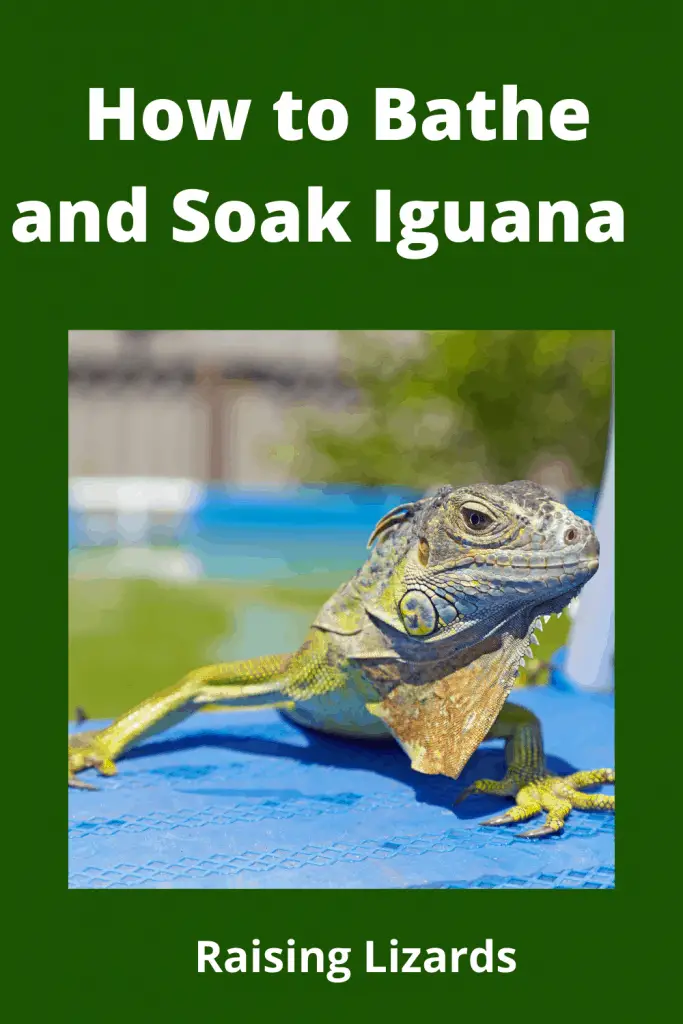Use plain water to clean your iguana. Don’t use soap or bubble baths on them because they could get stuck with dirt if there’s still some left after soaking for a while, so just try using baby shampoo in those cases instead – but otherwise make sure you always keep him dry by ensuring constant supervision throughout the process!
Iguana Bath – How to Bathe and Soak Iguana
In the wild iguanas are usually seen living near water, which they’re often swimming in lakes, rivers, and ponds. Most iguanas enjoy swimming and may naturally swim in deep waters. You should always have a leash on your iguana if letting it swim inside the deep pool.
Iguanas are often scared of bathtubs, especially in the beginning. This is because baths are deep and slippery. Many iguana, and wild iguanas, will try to escape when you put them in the bathtub, but it doesn’t mean that they are afraid of water. Start slowly, with shallow water, and build the iguana’s confidence. Iguana Bath – How to Bathe and Soak Iguana
Even though iguanas are natural swimmers and can hold their breath for an extended period, they can still drown when panicking.
Make sure to approach bathing calmly and don’t fill the bathtub with an excessive amount of water before your iguana is confident and laid back about bathing. Jump to 7 Reasons to Have a Pet Iguana

Start slowly and begin bathing your young iguana as soon as possible. You can start bathing your young iguana in a plastic tub, before moving to a bathtub. In fact, you don’t get to fill the bathtub with an excessive amount of water unless you would like iguana to swim.
Only after your iguana is ok about being within the bathtub, you’ll let it swim within the pool for a couple of exercise and activity.
How to Bathe and Soak Iguana / How Often
Daily bathing is the best idea for several reasons. Iguanas get to soak, which is sweet for iguana skin. Their surroundings have higher humidity, so they’re inhaling air with high moisture in it. Another benefit is that a lot of iguanas drink deeply when their bodies are in the water.
But the most popular reason pet iguana keepers bathe their iguanas daily is that most iguanas poop when they’re in the water. Keeping the enclosure clean is easy because it’s tons easier to empty the bath, thoroughly rinse the iguana, wash the bath out, then disinfect it before the next use by humans or iguana. This will help you clean and disinfect their water.
Helpful Fact – Iguanas who are new to baths often freak out. Acting like you’re trying to kill them, they thrash wildly, scrambling about trying to launch themselves out of the bathtub, over your head, and out of the space. This scene is enough to form many iguana pet owners anxiety, dry themselves off, and never try it again.
Type of Water
The water should be moderately warm, which is often, 82F – 84F, or 28 to 29 degrees Celsius hot, and it’ll gradually get cooled down. You can give your iguana a shower in your bathtub or its own special tub.
It’s a good idea not to fill the bath with an excessive amount of water such as the iguana’s whole body is under. The water should be about as deep as half the iguana’s height such only a part of its body is covered with water. Remember the animal is cold-blooded, which suggests its blood heat changes to match the temperature in its surroundings. Keeping it clean and disinfect.

So, confirm the water you’re using is warm, not hot, or cold. When the iguana is within the water, it’s going to defecate. Do not panic when it does this. Bath time defecation is normal for iguanas and an opportunity for you to potty train it. Clean the bathtub and disinfect it after use especially if it is the same bathtub you use for bathing.
Using Soaps / Yes or No
Don’t use soap to bathe your iguana. If your iguana has dirt or feces stuck to him after soaking for a fleeting time, you’ll use a couple of drops of baby soap and a washcloth or toothbrush thereon area, but otherwise, just use plain water. Also, never leave your iguana alone within the tub.
Your pet iguana when within the bathtub can drink some soap up, which might be toxic and a few of the scents could in time-kill, one more reason never to use when cleaning the enclosure (along with w/ bleach or the other chemical).
To flush out the infection you’ll add a touch little bit of Betadine. You should be sure that the iguana’s enclosure is kept super-duper clean. If you’re using bark, sand, rocks, pellets, moss, etc those are all bad floor cover (Substrate) to start and will be changed to the newspaper, paper towels, towels, vinyl flooring, indoor/outdoor carpeting. To make cleaning easier.
If you are going to use soap, which still is not the best, confirm that it’s child-safe soap or shampoo. You would like to form sure that you simply don’t give your iguana a shower while using child-safe soap or shampoo. Allow iguana to soak, then use a soft washcloth and use it on the cuts. You’ll use those to scrub stubborn dirt.
How Much Time for Bathing? 20 Minutes
Iguana must be kept a short time within the water when the iguana will soak the water in through his skin. But don’t wait for enough for the water to become cold, because it is going to be uncomfortable for the iguana. 20 minutes is enough for the iguana to soak the adequate moisture.

Drying your Iguana / Removing Shedding Skin
Wrap your iguana with a moist towel for five minutes to melt any remaining skin. If your iguana still doesn’t manage to shed completely after a shower, take a warm, damp towel and loosely wrap the iguana in it.
Confirm the iguanas head is exposed. Wrap a dry towel around the wet towel and let the iguana remain wrapped for about 5 minutes. After you’re taking the iguana out of the wrap, check to find if there’s still any dead skin around the toes and tail. If your iguana features a crest, spikes, or dewlap, check these areas also.
How to Keep Iguana Clean
Iguanas within the wild don’t properly groom themselves. Various objects in iguana’s natural environment within the wild help clean them. These include rocks and bark. Iguanas also tend to swim within the ponds and rivers to wash. You’ll bathe or soak your iguana during the day, it will poop in the water.
If you’ve got trained it to poop within the plastic tub that’s within the tank, then you’ll additionally soak your iguana within the bath a couple of times every week. Confirm to vary the water daily and have a separate bowl with the for drinking. Let’s now discuss the way to give your iguana a shower, step by step.
Step 1: Choose the Place for Bathing Your Iguana
First, you would like to plan where you’ll be bathing your iguana. You’ll choose the large plastic dish or tub for bathing and soaking younger iguanas. If your iguana is large, you’ll need to use the bath.
Never soak your iguana within the kitchen. If using the plastic tub, confirm it’s only used for your iguana. Bathing your iguana also can be a neighbourhood of potty training, and later actual daily pooping. Most owners potty train their iguana to poop within the plastic tub with water, or within the bathtub. During this, bathing is going to be a daily task.
If you want, then potty train your iguana to poop within the plastic tub with water, then move it to the cage. But it’s still an innovative idea to wash your iguana a couple of times every week.
Step 2: Prepare the Bathtub for Soaking and Bathing
Your iguana is going to fear a deep bathtub initially. To keep your iguana less frightened of a tub, confirm to put an anti-slip mat like this on the rock bottom of the bathtub.
What’s more, choose a delegated iguana towel and leave it on the side of the bathtub. This may give your iguana some sense of security. Your iguana will know that there’s an exit which it’s not getting stuck in there.
Then, fill the bathtub or the dish with warm water. The water level shouldn’t be above the iguana’s hips when standing. It’s a far better idea to fill the bathtub with water before you set your iguana inside. This may minimize the strain from feeling the running water.
Step 3: Confirm the Water is Warm Enough
Iguana is a cold-blooded lizard, and it relies on the warmth from the environment to remain warm. Therefore, you’ll get to confirm that the water within the bath is warm enough before you set your iguana in.
Your iguana is likely to be basking before you set it within the bath, and sudden drops in temperature will scare it. The simplest water temperature in an iguana’s bath should be around 84-85 degrees Fahrenheit (or 28.8-29.4 Celsius).
If your iguana is staying within the bath for quite 10 minutes, you’ll get to add more warm water. This is often if your iguana hasn’t pooped.
Tip – Please don’t use any soaps or shampoos for your iguana’s bath. The chemicals will irritate the skin and eyes, also dry out the skin. You’ll only use medicine prescribed by the vet or some reptile conditioner.
Step 4: Let your Iguana Soak
If your iguana is soaking for hydration, you’ll not get to do anything. You want to never add human soap or shampoo to the water. This is often because these products will dry out iguana’s skin. When iguana poops within the water, first let it poop, and alter the water before putting your iguana in water. This is often to be sure that your iguana doesn’t drink the soiled water.
Step 5: Let your Iguana Leave
After the soaking is finished, you’ll let your iguana climb out of the bathtub. Your iguana can attempt to climb out if you set the towel on the side of the bathtub. This may also assure your iguana that there’s nothing to stress about. And therefore, the next time it’ll know that the bathtub isn’t a scary place. You’ll also lift your iguana out of the bathtub. Dry iguana by wrapping it with a towel. You’ll gently dry the iguana’s skin, to let extra water soak in.
Step 6: Wash the Towel and also the Bathtub
After your return, your iguana within the cage, confirm to disinfect the bath. Also, wash the iguana’s washcloth and therefore the towel within the washer. Confirm you add some disinfectant to the washer to disinfect the towels. Clean all the opposite accessories and dry them for the next use.
Enclosure Tips to Simply Keep Iguanas clean
Enclosures must be easy to wash. Proper enclosures include glass aquariums or wooden enclosures coated with polyurethane and sealed with plastic, with well-fitted lids to stop the escape. Iguanas can grow quite large, up to four to five feet long, weighing 10 to fifteen pounds. It’s important to remember that, making the exhibit a minimum of twice its expected length as an adult.
Enclosure must be cleaned daily. Good choices for disinfecting agents include one-part bleach to twenty parts water, or a vinegar and water solution. you ought to always allow the enclosures to air dry.
Never clean with Lysol or other phenolic compounds because they’re lethal to iguanas.
Bedding can be of newspaper, paper towels or linen towels.
Cat litter, corn cob, cedar, and other aromatic excelsior are bad choices because they’ll cause dehydration and should be eaten, causing intestinal blockage.
Other items that ought to be included in habitats include rubbing objects, like rocks; hiding places, like a hollowed log; and durable branches for climbing. It’s okay to be creative, but confine mind that iguanas may attempt to eat plastic shrubs.
It’s extremely important that iguanas receive ultraviolet. This is often necessary for the conversion of vitamin D to its active form. the sole approved UV light recommended for iguanas is Vitra-Lite. the littlest daily requirement of UV light is 12 hours per day. Exposure to the sunshine source shouldn’t be constant, therefore hiding places are essential.
Foods and Vitamins Skin Health in Iguanas
Iguanas are herbivores and luxuriate in eating veggies, fruits, green salads, and plants. Iguanas are often omnivores within the wild and may eat small animals to survive, you shouldn’t be giving your iguana any live insects or animals. your ought to aim to feed your iguana mostly with vegetables and green leafy veggies for healthy skin.
Green vegetables and a few fruits will provide your iguana with proper nutrition and vitamins for healthy skin, also as an additional source of water.
When giving your iguana any lettuce occasionally, confirm to feed it extra food, as lettuce is usually made from water. That doesn’t mean that lettuce should be overlooked completely, it’ll provide your iguana with water, fiber, and a few vitamins permanently digestion and skin health.
The best foods to Feed Your Iguana for Skin Care:
Fruits, like plums (you should remove the stone), bananas, figs, melons, watermelons, apples, peaches, pears, pineapples, mangos, papayas, and even guava. Iguana also will enjoy berries like blueberries, raspberries, mulberries, and strawberries.

Chop these fruits into small pieces and take away any small stones to stop impaction or choking. Your iguana will appreciate delicious fruity deserts on their own or in their green salads! You’ll get your fruits from supermarkets or other shops. Vegetables, like chopped carrots, sweet peppers, zucchini (courgettes), pumpkins, sweet potatoes, different beans (lima, green, butter, snaps), corn, green and sugar peas, squash, and greens.
If you can’t find fresh vegetables for your iguana in winter, you’ll get frozen and a few canned vegetables. Chop veggies and fruits into small pieces that iguana can swallow.
Green leafy vegetables, like dandelion, kale, mustard, radish, collards, hibiscus leaves, and romaine lettuce (sometimes). you’ll also buy mixed leaf salads for extra diversity.
Iguana Diet
| Greens / 35% | Fruits / 15% | Fiber / 20% | Avoid | Supplements |
|---|---|---|---|---|
| leaves | Apples | Grain Bread | Meat | Calcium |
| Flowers | Peaches | Bran Cerial | Insects | phosphorus |
| lettuce | Guava | Bugs | D3 / Light / Supplement | |
| Alpha Hay | Kiwi | Rodents | Multivitamins | |
| Bok Choy | Melons | Dog Food | ||
| Clover | Figs | Cat Chow | ||
| Savory | Apricots | SoyBeans | ||
| Dandelions | Dates | Pesticides | ||
| Green Cabbage | Strawberries | Spinache | ||
| Green Beans | Raspberries | Rhubarb | ||
| Sprouts | Mangoes | Celry | ||
| Okra | Beetroot | |||
| Cucunbers | Chard | |||
| Carrots | Fried Chips | |||
| Asparagus | Leeks | |||
| Peas | Poisonous Mushrooms | |||
| Corn | ||||
| Collard | ||||
| Squash | ||||
| Edible Mushrooms |
Greens
Fruits
Avoid
Supplements
Pre-made Commercial Foods
These are able to eat and are usually fortified with extra vitamins and supplements. There are several sorts of foods available on the market made specifically for lizard’s skin health.
Confirm the food is moist before you provide it to iguana, as they swallow foods and don’t chew them.
These foods are usually dry, and your iguana must absorb water with its diet. Don’t ditch water. Water content is high in vegetables and fruits, provide a bowl with cold water for your iguana a day. Your iguana may additionally bathe and poop during this water, so confirm to vary it and clean the enclosure every other day.
Health Issues that Might Create Smelly Feces in Iguanas
Iguana feces are composed of two parts albeit it’s like three, sometimes. First is that the fecal pellet, or mass. this could be chocolate to black, evenly formed, soft but to not the purpose where it loses its form after it’s been deposited. A healthy iguana’s feces will smell fresh and green.
The other part of the waste is liquid urates. it’s clear and viscous. Some days it’s going to be waterier than others. Depending upon what has been eaten the day before, like raspberries, carrots, or cactus pear, the urates could also be tinged with red.
The opposite part of the urates may be a white stringy mass that sometimes is often seen within the urates, while other times in inside the fecal mass or threaded through or around it.
Diarrhea in Iguana
Parasite infections, including worms and protozoans, may cause a loosening of the fecal mass to the purpose where it does not hold its shape.
The urates could also be tinged reddish or rusty within the case of some protozoan infections. The feces of such iguanas often smell rank. When infected with Giardia, they’ll smell quite strongly, and strongly unpleasant.
The psychological upset can also cause temporary diarrhea as may a radical change in diet or eating a food item that doesn’t accept as true with the lizard’s gastrointestinal system.
Such temporary upsets could also be successfully countered by administering a little amount of non-fat yogurt having live cultures. Parasites can’t be so treated, however, and will not be treated with over-the-counter preparations found in pet stores.
A veterinarian must examine the feces to decide what organism is causing the matter and to prescribe the right doses of the right medication. Follow the directions for the primary and later doses of medication and have the feces rechecked a few weeks after the last dose to decide whether a further dose is going to be needed.
Constipation
An iguana who stops pooping daily while continuing to eat daily features a problem. The longer it goes without defecating, the more serious things. As wastes build up within the iguana’s system, organ failure may occur.
First, check the enclosure temperatures. Constipation occurring during the winter is caused by the ambient enclosure temperatures dropping unnoticed by the owner as of the general temperatures within the home fall in response to colder winter weather.
Adjusting the heating sources to supply the right basking and thermal gradient temperatures is usually all the is requires restoring regularity to the iguana.
Occasionally, bathing and massaging are going to be needed. Bathe in warm water for ten to fifteen minutes. Then gently massage the iguana’s belly, in smooth stokes from sternum to vent, for five minutes approximately while it’s still within the water.
Let the iguana stay within the warm water (refreshing as necessary to stay at the right temperatures) for a minimum of another 10-15 minutes. The iguana should defecate within 24 hours if the blockage is thanks to being too cool, an exceedingly small piece or two of the ingested substrates, or a really mild case of internal parasites.
If the blockage is because of heavy parasite infestation, a clump of ingested human or pet hair, or larger pieces or clumps of the substrate (or other foreign objects), then the washing or increased heat will have little to no effect and therefore the iguana must be seen by a vet for further diagnostic work-up and treatment.
It is not recommended to use laxatives, without a veterinarian consultation. Severe metabolic bone disease and paralysis can also cause constipation. Again, a vet visit and work-up are going to be needed to decide the cause and initiate treatment.
Conclusion – Iguana Bath – How to Bathe and Soak Iguana
How to Bath and Soak Iguana details on how to bathe your Iguana. Many Iguanas need to soak for two major reasons. Wild Iguana do it in nature is available, plain water sources. Hydration is accomplished by soaking in clean water. Also, the Iguanas usually defecate into the water. This along with proper feeding can keep your Iguana Healthy and his Skin Vibrant.

